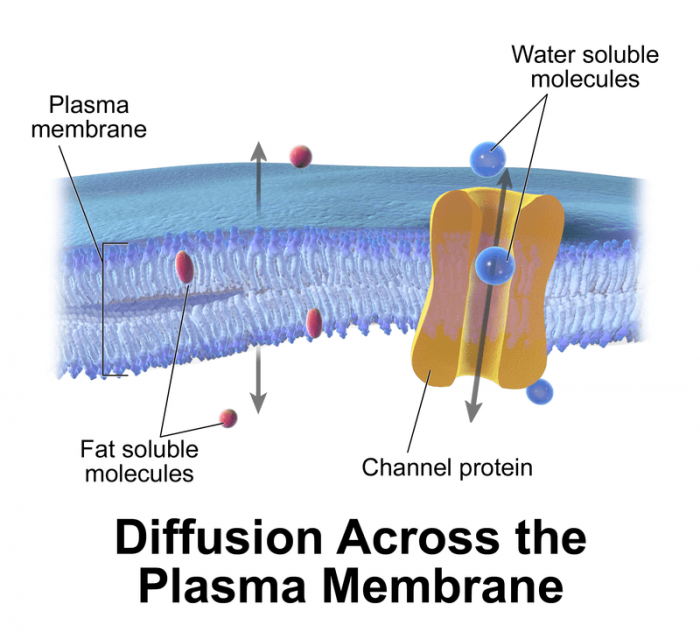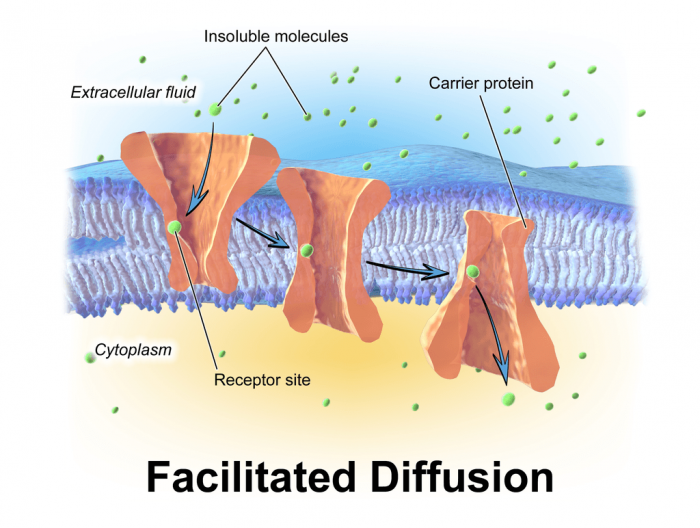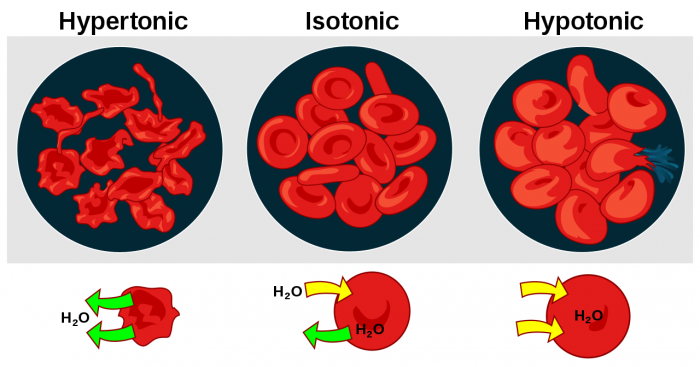
Facilitated diffusion is a process that enables the selective movement/transport of substances in and out of a cell. The cell membrane has pores within it that let certain types of substances pass through it but not others, and the movement of molecules across the cell membrane not utilizing chemical energy is facilitated diffusion. In other words, facilitated diffusion is a type of passive transport across a biological membrane.
What are the components that let facilitated diffusion take place? How is facilitated diffusion different from other forms of diffusion? In order to answer these questions, we’ll need to examine the cell membrane/plasma membrane and the process of facilitated diffusion more closely
The Structure Of The Cell Membrane

Photo: By BruceBlaus. When using this image in external sources it can be cited as:Blausen.com staff (2014). “Medical gallery of Blausen Medical 2014”. WikiJournal of Medicine 1 (2). DOI:10.15347/wjm/2014.010. ISSN 2002-4436. – Own work, CC BY 3.0, https://commons.wikimedia.org/w/index.php?curid=29140354
The process of diffusion across a cell membrane is possible because of the unique structure of the cell membrane, also referred to as the plasma membrane. The plasma membrane/cell membrane of a cell is made out of a phospholipid bilayer. This means that there are two layers made out of structure comprised of a hydrophobic or water-avoiding tail and a hydrophilic or water-loving head. The layers are arranged in such a fashion that the hydrophobic tails of both layers are pointed towards one another, meaning that the hydrophilic heads are on the outsides of the membrane. One row of heads faces inwards towards the cell, while the other row faces outwards towards the outer environment.
Found in between the phospholipid molecules are certain membrane proteins. The proteins assist the membrane in controlling what molecules move in and out of the cell.
The Facilitated Diffusion Process

Photo: By BruceBlaus. When using this image in external sources it can be cited as:Blausen.com staff (2014). “Medical gallery of Blausen Medical 2014”. WikiJournal of Medicine 1 (2). DOI:10.15347/wjm/2014.010. ISSN 2002-4436. – Own work, CC BY 3.0, https://commons.wikimedia.org/w/index.php?curid=28781688
Facilitated diffusion is where substances move through the cell membrane with the assistance of transport molecules. The transport is accomplished “passively” meaning it isn’t driven by the use of ATP/energy in the cell. When transport is accomplished with the expenditure of energy it is referred to as active transport. The facilitated diffusion process is responsible for the movement of solutes and ions, for example, amino acids and various sugars, out of and into the cell. Carrier molecules are molecules made out of proteins, and these molecules are responsible for assisting the movement of the ions and solutes. There is a difference between these protein-based carrier molecules and the protein channels. While the carrier molecules facilitate the movement of ions and solutes, the protein channels are simply just gaps in the membrane that let substances move in and out of the cell. The carrier proteins accomplish the movement of solutes and ions by binding to the substrate, pulling the substrate across the cell membrane and then letting the substrate go.
The rate of movement and the direction of the flow of molecules is dependent on the concentration of substances inside and outside of the cell, or the substance gradient. If there are more solutes inside of the cell than outside, than the solutes will expand outside of the cell until there are approximately equivalent amounts of solutes both inside the cell and just outside the cell. Conversely, if the concentration of the gradient is greater on the outside of the cell, the solutes will be transported to the inside of the cell.
An important attribute linked with facilitated diffusion is saturation. Facilitated diffusion is a saturable process, meaning that when the concentration gradient increases for the substances the concentration of the gradient will continue to increase until the cell becomes fully saturated. The concentration will continue to increase until the process hits a point where the respective molecules are all occupied. The substance will reach a saturation point regardless of the initial state of the gradient, regardless of the concentrations inside or outside of the cell at the beginning of the process.
One example of facilitated diffusion can be seen in the movement of erythrocytes or red blood cells. Red blood cells have a cell membrane which can move ions of chloride in a given direction and is capable of taking bicarbonate ions back in the other direction. This mechanism is how carbon dioxide is moved into the lungs from cells that have absorbed oxygen for use.
In sum, facilitated diffusion is an important process that enables cells in the body to maintain homeostasis.
Why Is Facilitated Diffusion Necessary?
So why is facilitated diffusion necessary for cells? Cells need processes like facilitated diffusion because the cell membrane is permeable to only a select few types of molecules. The molecules that are allowed to move across the cell membrane must be non-polar molecules which are small in size. Molecules like carbon dioxide, oxygen, and water are capable of moving across the cell membrane, but almost every nutrient, biopolymer, and other small molecules cannot move across the membrane, and thus facilitated diffusion is necessary.
As an example of the types of molecules which must be transported by facilitated diffusion, consider glucose. Glucose is a fairly large molecule that can’t diffuse through the cell membrane and must be transported by protein carriers. Ions of calcium, potassium, sodium and similar are repelled by the lipophilic cores of the cell membranes due to having a charge, and also must be moved using facilitate diffusion. Nucleic acids and amino acids are polar molecules, and they are also typically too large in size to be able to move in and out of a cell using simple diffusion.
The carrier proteins involved in the facilitated diffusion process frequently have one of two different forms. The default form of the carrier protein is often changed when a molecule is attached to the protein. One side of the molecule attaches itself to one side of the membrane, which prompts a change in the carrier protein’s three-dimensional structure that lets it pass through the membrane’s other side. Binding-related changes in the carrier proteins let both the carrier protein and the molecule they are carrying pass through the cell membrane.
As previously mentioned, proteins which form channels possess small pores that only allow certain kinds of molecules to pass through. There are many different mechanisms that work in conjunction to control what kinds of molecules can pass through the cell membrane and the channel proteins. Some channel proteins are so discriminatory that they can display a thousand-fold preference for a chosen molecule over molecules that have similar biochemistry.
Other Types Of Diffusion
Outside of facilitated diffusion, there are other forms of diffusion as well. Passive diffusion refers to the movement of molecules across the cell membrane without the use of protein channels used in facilitated diffusion. Because cell membranes are composed of a phospholipid bilayer, hydrophobic molecules are able to transverse through the cell membrane. Carbon dioxide, nitrogen, and oxygen are examples of small nonpolar molecules which can pass freely through the plasma membrane. Remember that large polar molecules cannot pass freely through the cell membrane and must be moved through the protein channels.
Osmosis is similar to diffusion, yet classified as being different from either facilitated diffusion or passive diffusion. Osmosis is a process that has water molecules distribute themselves over a concentration gradient, freely moving across a semi-permeable membrane. How exactly are “free” water molecules defined? Free water molecules are molecules which aren’t currently interacting with particles of solute like ions of salt. The result of the osmosis process is a difference in the concentration of water across the membrane, changing until equilibrium is reached. This function of biological organisms is necessary for a cell to be able to maintain homeostasis and survive.

Photo: By LadyofHats – did it myself based on [1], [2] ,[3] and [4]., Public Domain, https://commons.wikimedia.org/w/index.php?curid=1685492
If the state of the solution is isotonic, it means that the fluid in the outside environment has the same concentration as the concentration on the inside of the cell. The term hypotonic is used when describing a lesser concentration, so a hypotonic solution is a condition where the concentration of solutes is lower in the outside environment compared to the cell, meaning that the solutes will distribute themselves and move outside from the interior of the cell to reach equilibrium. Finally, a hypertonic solution refers to a situation where the concentration of the solution is greater in the environment outside of the cell than inside of the cell, and under these conditions, some of the solution will disperse from the outside environment to the interior of the cell.








